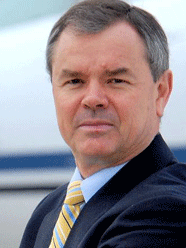
Over
the last few years, while
home-grown air cargo outfits
have started and virtually
withered away—the
most recent example being
Capt. G. R. Gopinath’s
Deccan 360 and Capt. Mukut
Pathak’s Aryan Cargo
Express (ACE)—the
role of non-scheduled
air cargo operators who
operate chartered flights
is gaining importance.
At
the recent Indian Business
Aviation Expo, Dhiraj
Mathur, Executive Director
and Leader of Aerospace
and Defense Practice at
PricewaterhouseCoopers
India (pwc) pointed out
that India was ready to
witness rapid growth in
the business aviation
sector primarily due to
the country’s geographic
location and economic
growth. India’s
geography offered an opportunity
for growth of general
and non-scheduled aviation
due to the rising demand
from the business houses
in the country. India,
according to Directorate
General of Civil Aviation
records, has seen a whopping
rise in the number of
non-scheduled airline
operators: from 36 in
2000 to more than 200
in 2011.
.gif) The
number of jets and helicopters
is estimated to jump from
600 in 2011 to about 1,800
aircraft by 2020, according
to Capt. Karan Singh,
(left) CEO of Indo-Pacific
Aviation and MD of Business
Aircraft Operators Association
(BAOA). The
number of jets and helicopters
is estimated to jump from
600 in 2011 to about 1,800
aircraft by 2020, according
to Capt. Karan Singh,
(left) CEO of Indo-Pacific
Aviation and MD of Business
Aircraft Operators Association
(BAOA).
While
no figures exist of how
many of this number transport
cargo, those in the business
estimate that quite a
few do. In 2010, for example,
cargo traffic by NSOs
from Kolkata Airport was
highest in the country—9.6
percent of the total freight
uplift from the airport,
followed by Delhi (7.9),
Hyderabad (7.1) and Bengaluru
(6.7). Simply put, there
is a demand for more cargo
than that carried by regular
carriers.
According
to Capt. Karan Singh,
the mindset of the cargo
industry in the country
has to change. The idea
of using business aircraft
for air cargo is still
a growing one. However,
a number of companies
have started using business
jets to transport sensitive
equipment, spares, documents,
etc.—especially
those that are time-critical.
Despite
the high figures and the
potential, the air charter
business as far as cargo
is concerned has been
facing headwinds. According
to Shailendra Seth, Director,
Chapman Freeborn, there
are opportunities enough
in India with the rapid
growth in the economy.
However, the business
requires infrastructural
support and an end to
rules that make operators
go around in circles.
The air charter business
between India and Africa,
China, and even Europe
and Russia is growing.
Chapman handles a variety
of airplanes regularly
from the AN-124 to the
A 310. The business has
been growing so fast—the
sector saw three times
more growth in 2010 from
India than 2009—that
Chapman opened an office
in Mumbai and is looking
to start one in Chennai.
Another
international charter
service, Air Charter Service
(ACS), recently started
its first Indian office
in Mumbai, offering both
cargo and passenger services.
 Said
Tony Bauckham, (right)
Managing Director, “India
is a huge emerging market
and the ninth largest
economy in the world.
We have been planning
this office opening for
some time now as we already
have a strong client base
here and felt that a local
presence was essential
to further grow our market
share . . . Mumbai is
one of the top ten centers
of commerce in the world,
and so was the stand out
candidate for the office’s
location.” Said
Tony Bauckham, (right)
Managing Director, “India
is a huge emerging market
and the ninth largest
economy in the world.
We have been planning
this office opening for
some time now as we already
have a strong client base
here and felt that a local
presence was essential
to further grow our market
share . . . Mumbai is
one of the top ten centers
of commerce in the world,
and so was the stand out
candidate for the office’s
location.”
 Market-wise
aircraft manufacturers
also speak of the growth
potential of India. “I
would say India is the
second most important
market in Asia and will
drive the growth over
the next ten years,”
said Jose Eduardo Costas,
(left) VP-Sales and Marketing
Embraer Executive Jets,
Asia Pacific, while on
the sidelines of India
Aviation 2012, the country’s
premier airshow held every
other year at Hyderabad, Market-wise
aircraft manufacturers
also speak of the growth
potential of India. “I
would say India is the
second most important
market in Asia and will
drive the growth over
the next ten years,”
said Jose Eduardo Costas,
(left) VP-Sales and Marketing
Embraer Executive Jets,
Asia Pacific, while on
the sidelines of India
Aviation 2012, the country’s
premier airshow held every
other year at Hyderabad,
The
constant refrain from
the handful of NSOs has
been the lack of support
from government agencies
that provide infrastructural
support. They have been
demanding that the facilities
provided to scheduled
cargo operators should
also be provided to non-scheduled
operations.
Initiatives,
however, have been seen
over the past few months.
At the end of last year,
for example, the first
dedicated air cargo service
was started in the North
East of the country, a
region of low connectivity.
The service, operated
by  Rudra
GTL Aviation Pvt. Ltd,
started with flights from
Kolkata to Imphal. Incidentally,
Rudra GTL’s routes
stretch from one corner
of the North East to the
other, connecting Kolkata
to Guwahati, Imphal, Agartala,
and Bagdogra. The carrier
has wet-leased two ATR-72
aircraft for the flights,
each with a capacity of
seven tonnes. According
to Manosij Roy, Director
of Rudra GTL Aviation,
“The market is a
huge and untapped one
and to prove it we have
got bookings for the next
year.” Rudra
GTL Aviation Pvt. Ltd,
started with flights from
Kolkata to Imphal. Incidentally,
Rudra GTL’s routes
stretch from one corner
of the North East to the
other, connecting Kolkata
to Guwahati, Imphal, Agartala,
and Bagdogra. The carrier
has wet-leased two ATR-72
aircraft for the flights,
each with a capacity of
seven tonnes. According
to Manosij Roy, Director
of Rudra GTL Aviation,
“The market is a
huge and untapped one
and to prove it we have
got bookings for the next
year.”
On
the other side is Naki
Air Cargo, from far-away
Miami in the USA. Based
in Florida, Naki is preparing
to start all-cargo air
service directly from
the southern coastal city
of Vishakapatnam to Dubai.
The new service, according
to Capt Rajan Nair, COO,
“will be of enormous
benefit to local manufacturers,
and other shippers, who
currently have to move
their goods through several
distant airports in order
to get to the UAE, or
to connect with international
air cargo flights to destinations
in Europe and North and
South America.”
Vishakapatnam is home
to one of the country’s
leading sectors, pharmaceutical,
and the IT industry based
in Andhra Pradesh. In
addition, the region is
home to a large expatriate
population in the UAE.
Capt.
Nair informed us that
Naki Air was a leading,
innovative charter operator
that specialized in establishing
new cargo and passenger
services that is customized
to meet the needs of its
customers. In India, it
will be offering services
in conjunction with a
UAE-based air-cargo operator.
It has the capacity to
utilize either A300-600
or B 727-200 freighter
aircraft, depending on
the cargo needs of customers.
The carrier’s operation
will be able to connect
with major long-haul cargo
carriers to provide seamless
connections to Europe
and North America, and
to provide a global reach
for its customers.
According
to Hercules Aviation’s
Sujeen Paulose, though
there was a great demand
for air cargo charters,
they would be going lower
because of the infrastructure.
He felt that there was
a great need for X-ray
machines that could take
care of outsized cargo.
Also, goods could not
be delayed at the airport—such
delays frustrated NSOs.
He also mentioned that
since most of the airports
in the country were slot-based,
a small delay of 10 minutes
could lead to the diversion
of flights.
Another
manufacturer also at the
India Aviation show was
the French Dassault showcasing
their Falcon 2000s. Gilles
Gautier, Vice President
(Sales and Marketing),
and Vadim Feldzer, Public
Relations and Communications
Manager, were vocal about
the issues restricting
the growth of general
aviation in India. They
pointed out that “regulations
and infrastructure”
were the main issues “because
customers will need a
bigger infrastructure
. . . China started behind
India but they are progressing
very fast.”
There
are 150 airports in India
that are capable of handling
general aviation aircraft.
However, there is significant
variation in the level
of infrastructure and
facilities available at
these airports. Aviation
infrastructure capable
of handling big commercial
jets is not readily available
in most of the Tier II
and III cities in the
country.
Tirthankar
Ghosh
|



